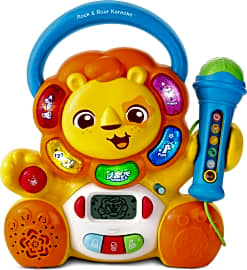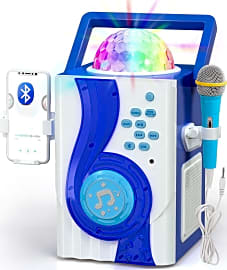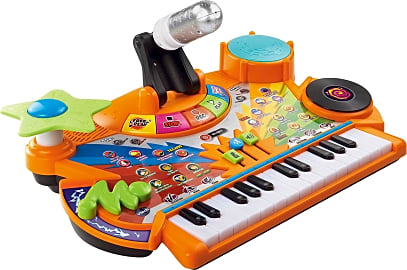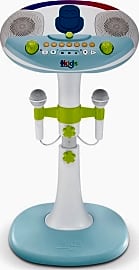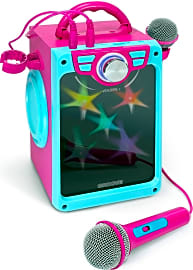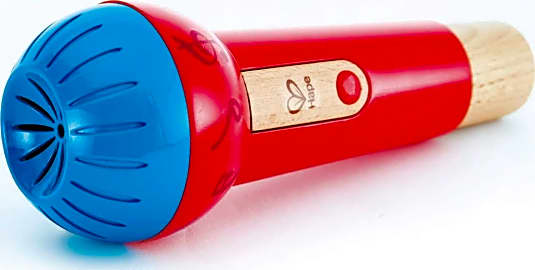The 8 Best Kids Karaoke Machines

This wiki has been updated 39 times since it was first published in December of 2016. Get your little ones started on their way to stardom with one of these kids' karaoke machines. These singing devices are tons of fun, whether practicing in a room by themselves or performing for friends and family. We've included options that are compatible with a variety of inputs, from Bluetooth to USB to AUX cable, and some even come with built-in tracks and sound effects. When users buy our independently chosen editorial recommendations, we may earn commissions to help fund the Wiki.
Editor's Notes
December 17, 2020:
We removed a number of items due to availability concerns and replaced them with selections covering a range of features and functions. In addition to models designed for older kids, we included some options that are safe for toddlers to use. Several of these machines include fun light effects in addition to audio, which can be a nice touch at a party and help kids feel like they're really putting on a show. Some options are rechargeable while others require batteries, but most are portable for fun on-the-go.
November 04, 2019:
Our selections include a mix of more stationary options and hand-held microphones. While the stationary options tend to provide better sound, younger children don't like to stay in once place very long, so models like the Karao King KTV allow them to roam.
We also added the iKaraoke Portable, which is more geared towards teens, and makes a great sleepover option for any age that can read.
We replaced the Singing Machine SML385BTW with the Singing Machine Pedestal from the brand's kids line because it has more child-friendly features and controls. And while the SML385BTW looks more like a grown-up's machine, it doesn't have any better sound than the kid's model.
We had to remove the popular Disney Frozen unit because it's no longer available. Unfortunately, we could not replace it with the Frozen 2 model because it doesn't even come loaded with any Disney music, doesn't display any lyrics, and is really just a boombox with the characters on the front.
A Brief History Of Karaoke
He asked Inoue to record even more tracks for him, giving Inoue the inspiration for something he would call the Juke 8.
Look, I get it — when you're up behind the mic belting out Holding Out for a Hero, you'd like to believe that no one keeps records when it comes to karaoke. However, there are a few things we know about the history of amateur public singing.
The hobby began in Japan, created by a keyboardist named Daisuke Inoue. One day a businessman approached him with a problem: the executive would be expected to sing in front of his clients at an upcoming party, but he felt like his voice only sounded good when paired with Inoue's music.
Inoue recorded a few tracks he thought would complement the businessman's voice, and the man was ecstatic with the results. He asked Inoue to record even more tracks for him, giving Inoue the inspiration for something he would call the Juke 8.
The Juke 8, released in 1971, was basically a microphone, amp, and 8-track car stereo. It didn't have any method for displaying lyrics, and you had to provide your own music.
Once a few Osaka club owners took a chance on the machine (and patrons figured out how they worked), the Juke 8s began to sell like hotcakes. The karaoke craze soon spread to Tokyo, and it wasn't long before the whole world wanted a chance to strut their stuff on stage, which would have been excellent news for Inoue except for the fact that he never patented his invention.
While Inoue might not have gotten rich, the fact that many competing manufacturers could develop machines led to rapid improvements on the technology. In the early 1980s, many models scrapped cassette tracks for laserdisc players, which meant that, for the first time, the singer could read the lyrics while performing.
The next major innovation was the creation of machines that drew off of a central database of songs. Previously, you could only perform songs that the venue owner physically had on hand, but having a central database allowed for a much wider array of choices (while also making it impossible to lie and say that you didn't have Baby Got Back when a drunk frat boy requested it).
Karaoke has since become one of the most popular pastimes in the world, with amateur singers filling bars every night of the week to let off some steam. In fact, it's become such a hit that personal machines are now being sold, so that you can enjoy singing in the privacy of your own home — no audience required.
Finding The Right Karaoke Machine
If one of your kids has a set of golden pipes (or just thinks that they do), you might want to encourage their talent by purchasing them a karaoke machine. Below are a few things to keep in mind before pulling the trigger on a purchase.
If your children are on the younger side, durability is an important consideration. There's a good chance this thing is going to take a beating, so you'll want to find a model that can handle it — or one that's cheap to replace.
Below are a few things to keep in mind before pulling the trigger on a purchase.
This might mean skimping on audio quality, but unless your kid is particularly serious about singing, they'll be unlikely to notice the difference. Now, if the whole family will be using it — and they should — then you might want to consider upgrading.
Take a look at the size, as well. Most kids will want to take their new toy with them when they visit friends (and that means you'll owe some other parents big time), so make sure it's something they can easily carry around.
The song database is extremely important, as that will be the biggest factor in determining whether the machine holds your child's interest. Look for one that has a vast selection of songs your kid loves, and check to see if you can add more later.
Beyond that, there is a variety of options that may or may not interest you. You can add anything from flashing lights to voice effects, and some even give you the ability to rate the singer, which is fantastic if you've been worrying that your kids aren't fighting enough. Shop around and see what, if anything, you absolutely need.
Karaoke machines are fun for all ages, and make a great gift that your child is sure to love.
Throwing The Perfect Kids' Karaoke Party
Once word spreads that your child has a karaoke machine, expect every child in the entire neighborhood to want to give it a test drive — and the easiest way for everyone to showcase their skills is to host a karaoke party.
With just a little bit of effort, you can throw a karaoke bash that will be the talk of the neighborhood for weeks to come.
Karaoke is all about living the dream, so set the stage from the very beginning. This can mean creating invitations that look like concert tickets or decorating the house to resemble a sold-out arena. Very few people ever get the chance to be rock stars, so this may be the only moment of musical glory some of these kids ever get.
Also, don't be afraid to really kick out the jams, if only just this once. Hook up the machine to your speakers and really unleash the power of rock.
It's important to keep an eye on the participation levels, as well. Some kids will need encouragement to get over their stage fright, while others will require you to pry the microphone out of their sticky little hands. Make sure that everyone gets a turn, and that everyone gets encouragement (unless, of course, a kid decides to sing Every Rose Has Its Thorn).
With just a little bit of effort, you can throw a karaoke bash that will be the talk of the neighborhood for weeks to come. Of course, you'll likely find that, after everyone goes home, the silence they leave behind is the most satisfying track of all.


